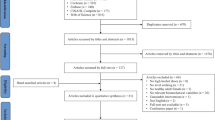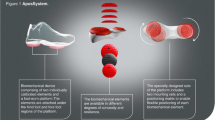Abstract
The aim of this review is to collect and discuss the current best evidence published in literature about the effect of the Masai Barefoot Technology(MBT) shoes on gait and muscle activation and try to draw conclusions on the possible benefits. We searched Medline, CINAHL, Embase and the Cochrane Central Registry of Controlled Trials. The reference lists of the previously selected articles were then examined by hand. Only studies comparing biomechanical and clinical outcomes were selected. Review, anatomical studies, letter to editor and instructional course were excluded. Finally, all the resulting articles were reviewed and discussed by all the authors to further confirm their suitability for this review: in the end, 22 articles were included. A total of 532 patients presenting a mean age of 34.3 years were studied. All patients evaluated were healthy or amateur sports except in two studies where only obese subjects and knee osteoarthritis patients were involved. Seven studies evaluated only male subjects, whereas four studies evaluated only female. Twelve of twenty-two studies performed electromyographic analyses. Weight was reported in 19 studies, whereas body mass index were reported only in a five studies. All studies reported kinematic analysis of shoe effects and compared the relationship between muscle recruitment and electromyographic activity. Unstable footwears were shown to immediately alter the stability in gait during daily-life activities. The center of body pressure is moved posteriorly with a consequent posterior displacement of the upper part of body in order to regain an appropriate body balance, and these postural changes are associated with an overall increase in the activity of lumbar erector spine muscles, as well as certain lower limb muscles. Current literature provides enough cues to conclude for a beneficial role of MBT shoes in the postural and proprioceptive recovery, but from the same literature cannot be drown clear and appropriate guidance to determine more in detail their indication for specific pathological conditions or for particular phases of the musculoskeletal recovery process.

Similar content being viewed by others
References
Buchecker M, Stoggl T, Muller E (2013) Spine kinematics and trunk muscle activity during bipedal standing using unstable footwear. Scand J Med Sci Sports 23(3):e194–e201. doi:10.1111/sms.12053
Buchecker M, Lindinger S, Pfusterschmied J, Muller E (2013) Effects of age on lower extremity joint kinematics and kinetics during level walking with Masai barefoot technology shoes. Eur J Phys Rehabil Med 49(5):675–686
Gross MT, Mercer VS, Lin FC (2012) Effects of foot orthoses on balance in older adults. J Orthop Sports Phys Ther 42(7):649–657. doi:10.2519/jospt.2012.3944
Caraffa A, Cerulli G, Projetti M, Aisa G, Rizzo A (1996) Prevention of anterior cruciate ligament injuries in soccer. A prospective controlled study of proprioceptive training. Knee Surg Sports Traumatol Arthrosc 4(1):19–21
Waddington G, Seward H, Wrigley T, Lacey N, Adams R (2000) Comparing wobble board and jump-landing training effects on knee and ankle movement discrimination. J Sci Med Sport Sports Med Aust 3(4):449–459
Lamo-Espinosa J, Troncoso S, Valenti-Azcarate A, Diaz de Rada P, Valenti-Nin JR (2014) Clinical and radiological short-term complications after single-stage bilateral uncemented total hip arthroplasty. Musculoskelet Surg. doi:10.1007/s12306-014-0342-z
Branthwaite H, Chockalingam N, Pandyan A, Khatri G (2013) Evaluation of lower limb electromyographic activity when using unstable shoes for the first time: a pilot quasi control trial. Prosthet Orthot Int 37(4):275–281. doi:10.1177/0309364612464812
Romkes J, Rudmann C, Brunner R (2006) Changes in gait and EMG when walking with the Masai Barefoot Technique. Clin Biomech 21(1):75–81. doi:10.1016/j.clinbiomech.2005.08.003
Taniguchi M, Tateuchi H, Takeoka T, Ichihashi N (2012) Kinematic and kinetic characteristics of Masai Barefoot Technology footwear. Gait Posture 35(4):567–572. doi:10.1016/j.gaitpost.2011.11.025
Li JX, Hong Y (2007) Kinematic and electromyographic analysis of the trunk and lower limbs during walking in negative-heeled shoes. J Am Podiatr Med Assoc 97(6):447–456
Roberts S, Birch I, Otter S (2011) Comparison of ankle and subtalar joint complex range of motion during barefoot walking and walking in Masai Barefoot Technology sandals. J Foot Ankle Res 4:1. doi:10.1186/1757-1146-4-1
Jackman RW, Kandarian SC (2004) The molecular basis of skeletal muscle atrophy. Am J Physiol Cell Physiol 287(4):C834–C843. doi:10.1152/ajpcell.00579.2003
Spector SA (1985) Trophic effects on the contractile and histochemical properties of rat soleus muscle. J Neurosci 5(8):2189–2196
Landry SC, Nigg BM, Tecante KE (2010) Standing in an unstable shoe increases postural sway and muscle activity of selected smaller extrinsic foot muscles. Gait Posture 32(2):215–219. doi:10.1016/j.gaitpost.2010.04.018
Yamamoto T, Ohkuwa T, Itoh H, Yamazaki Y, Sato Y (2000) Walking at moderate speed with heel-less shoes increases calf blood flow. Arch Physiol Biochem 108(5):398–404. doi:10.1076/apab.108.5.398.4296
Nigg BM, Emery C, Hiemstra LA (2006) Unstable shoe construction and reduction of pain in osteoarthritis patients. Med Sci Sports Exerc 38(10):1701–1708. doi:10.1249/01.mss.0000228364.93703.53
Buchecker M, Wagner H, Pfusterschmied J, Stoggl TL, Muller E (2012) Lower extremity joint loading during level walking with Masai barefoot technology shoes in overweight males. Scand J Med Sci Sports 22(3):372–380. doi:10.1111/j.1600-0838.2010.01179.x
Demura T, Demura S (2012) The effects of shoes with a rounded soft sole in the anterior–posterior direction on leg joint angle and muscle activity. Foot 22(3):150–155. doi:10.1016/j.foot.2012.02.004
Demura T, Demura S, Yamaji S, Yamada T, Kitabayashi T (2012) Gait characteristics when walking with rounded soft sole shoes. Foot 22(1):18–23. doi:10.1016/j.foot.2011.09.002
Forghany S, Nester CJ, Richards B (2013) The effect of rollover footwear on the rollover function of walking. J Foot Ankle Res 6(1):24. doi:10.1186/1757-1146-6-24
Forghany S, Nester CJ, Richards B, Hatton AL, Liu A (2014) Rollover footwear affects lower limb biomechanics during walking. Gait Posture 39(1):205–212. doi:10.1016/j.gaitpost.2013.07.009
Nigg B, Hintzen S, Ferber R (2006) Effect of an unstable shoe construction on lower extremity gait characteristics. Clin Biomech 21(1):82–88. doi:10.1016/j.clinbiomech.2005.08.013
Nigg BM, Davis E, Lindsay D, Emery C (2009) The effectiveness of an unstable sandal on low back pain and golf performance. Clin J Sport Med 19(6):464–470. doi:10.1097/JSM.0b013e3181c0a96f
Nigg BM, Tecante GKE, Federolf P, Landry SC (2010) Gender differences in lower extremity gait biomechanics during walking using an unstable shoe. Clin Biomech 25(10):1047–1052. doi:10.1016/j.clinbiomech.2010.07.010
Price C, Smith L, Graham-Smith P, Jones R (2013) The effect of unstable sandals on instability in gait in healthy female subjects. Gait Posture 38(3):410–415. doi:10.1016/j.gaitpost.2013.01.003
Ramstrand N, Thuesen AH, Nielsen DB, Rusaw D (2010) Effects of an unstable shoe construction on balance in women aged over 50 years. Clin Biomech 25(5):455–460. doi:10.1016/j.clinbiomech.2010.01.014
Sacco IC, Sartor CD, Cacciari LP, Onodera AN, Dinato RC, Pantaleao E Jr, Matias AB, Cezario FG, Tonicelli LM, Martins MC, Yokota M, Marques PE, Costa PH (2012) Effect of a rocker non-heeled shoe on EMG and ground reaction forces during gait without previous training. Gait Posture 36(2):312–315. doi:10.1016/j.gaitpost.2012.02.018
Stewart L, Gibson JN, Thomson CE (2007) In-shoe pressure distribution in “unstable” (MBT) shoes and flat-bottomed training shoes: a comparative study. Gait Posture 25(4):648–651. doi:10.1016/j.gaitpost.2006.06.012
Stoggl T, Haudum A, Birklbauer J, Murrer M, Muller E (2010) Short and long term adaptation of variability during walking using unstable (Mbt) shoes. Clin Biomech 25(8):816–822. doi:10.1016/j.clinbiomech.2010.05.012
Laughton CA, Slavin M, Katdare K, Nolan L, Bean JF, Kerrigan DC, Phillips E, Lipsitz LA, Collins JJ (2003) Aging, muscle activity, and balance control: physiologic changes associated with balance impairment. Gait Posture 18(2):101–108
Gregory DE, Callaghan JP (2008) Prolonged standing as a precursor for the development of low back discomfort: an investigation of possible mechanisms. Gait Posture 28(1):86–92. doi:10.1016/j.gaitpost.2007.10.005
O’Sullivan P, Dankaerts W, Burnett A, Straker L, Bargon G, Moloney N, Perry M, Tsang S (2006) Lumbopelvic kinematics and trunk muscle activity during sitting on stable and unstable surfaces. J Orthop Sports Phys Ther 36(1):19–25. doi:10.2519/jospt.2006.36.1.19
Papalia R, Zampogna B, Torre G, Lanotte A, Vasta S, Albo E, Tecame A, Denaro V (2014) Sarcopenia and its relationship with osteoarthritis: risk factor or direct consequence? Musculoskelet Surg 98(1):9–14. doi:10.1007/s12306-014-0311-6
Behm DG, Drinkwater EJ, Willardson JM, Cowley PM (2010) The use of instability to train the core musculature. Appl Physiol Nutr Metab 35(1):91–108. doi:10.1139/H09-127
Erfani MA, Pourabbas B, Nouraie H, Vadiee I, Vosoughi AR (2014) Results of fusion and instrumentation of thoracic and lumbar vertebral fractures in children: a prospective ten-year study. Musculoskelet Surg 98(2):107–114. doi:10.1007/s12306-014-0313-4
Notarnicola A, Maccagnano G, Di Leo M, Tafuri S, Moretti B (2014) Overload and neovascularization of Achilles tendons in young artistic and rhythmic gymnasts compared with controls: an observational study. Musculoskelet Surg 98(2):115–120. doi:10.1007/s12306-013-0275-y
Conflict of interest
None.
Ethical standard
This article does not contain any studies with human participants or animals performed by any of the authors.
Author information
Authors and Affiliations
Corresponding author
Rights and permissions
About this article
Cite this article
Papalia, R., Di Pino, G., Tecame, A. et al. Biomechanical and neural changes evaluation induced by prolonged use of non-stable footwear: a systematic review. Musculoskelet Surg 99, 179–187 (2015). https://doi.org/10.1007/s12306-015-0350-7
Received:
Accepted:
Published:
Issue Date:
DOI: https://doi.org/10.1007/s12306-015-0350-7




